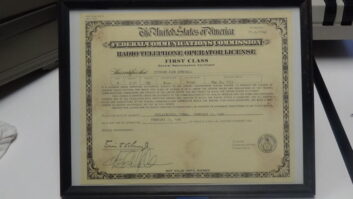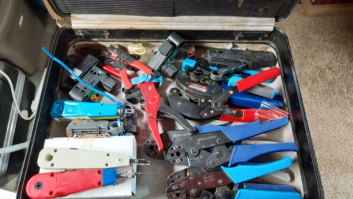
This article originally appeared in TV Technology.
Ham radio operators have been using the shortwave (“high-frequency” or HF) bands for data communications for over 50 years, but the data rates are much less than those available with dial-up modems. HF communications have the advantage that they don’t depend on vulnerable satellites, don’t require line-of-sight, and can cover huge distances under the right conditions.
The FCC recently granted two companies experimental licenses to use HF bands for data communications at far greater bandwidths and data rates than have been used by amateur radio operators. While these communication systems are being developed for the military, it’s possible some of the techniques developed could be used for digital broadcasting in the AM band, or more likely for shortwave broadcasting where skywave propagation is important.
According to the commission’s Office of Engineering and Technology Experimental Licensing Branch’s list of experimental applications between 10/1/14 to 10/31/14, license WH2XCI was granted to The MITRE Corp. to operate in the 2505–4100 kHz, 4210–4995 kHz, 5005–6210 kHz, 6320–8250 kHz, 8450–9995 kHz, 10005–12200 kHz, 13500–14990 kHz and 15010–16000 kHz bands to test HF communications at fixed locations in Bedford and Worcester in Massachusetts and Oneida and Rome in New York.
MITRE’s application states, “While satellite communication provides high data rate connectivity, there are vulnerabilities that include degradation and disruption of service. HF radio communication generally are limited to narrower bandwidths and lower data rates than satellite communications. To ensure critical communications are maintained, we are investigating the capability of higher bandwidth and higher data rate communications in the HF band applying polarization diversity MIMO concepts.”
The goal, according to the application, is to obtain reliable communications at a data rate between 1 and 4 bits/Hzps. MITRE said it will develop a 100 kHz bandwidth waveform that can achieve approximately 256 kbps with forward error correction (FEC) coding. MITRE will attempt to use both X and O modes to carry independent communications channels. PA0SIM has an excellent description of the X and O modes at XO propagation Web page.
In addition to the 100 kHz bandwidth, MITRE’s license allows bandwidths up to 1 MHz. MITRE states, “A stretch goal is to extend to wider bandwidth waveforms, up to 1 MHz.” The researchers’ note: “we understand that this wideband waveform may run up against other users and possibly cause interference. We plan to transmit at as low a power as possible and on a not-to-interfere basis.”
According to the license, MITRE will use emissions with the designators 5K00Q3N, 500KD7D, 500Q3N, 500W7D, 1M00D7D, 1M00Q3N and 1M00D7W. These designators imply maximum bandwidths of 5 kHz, 500 kHz and 1 MHz. The authorized effective radiated power ranges from 6 W to 122 W, depending on frequency and bandwidth. The license includes a condition stating “Licensee should be aware that other stations may be licensed on these frequencies and if any interference occurs, the licensee of this authorization will be subject to immediate shut down.” MITRE application shows the equipment being used includes nine Ettus N210 software defined radios, six Minicircuits ZHL-5W-1 and six BAE Australia “TBD — 50 W unit.” Apparently these are the power amplifiers.
MITRE’s application describes the antennas — crossed dipoles and verticals — that will be used in testing to isolate the X and O propagation modes. You find the application, associated exhibits, and the grant using the Experimental Licensing System Call Sign Search and entering call sign WH2XCI. MITRE will be using
Another interesting license grant is WG2XZF to TrellisWare Technologies, Inc. It is an experimental license to operate between 1.800 and 12.00 MHz “to implement and field test the design of an advanced HF waveform” mobile in Julian, Calif. The application shows the emission type as 30K0D7D, significantly narrower than the MITRE filing, utilizing QPSK to 64 QAM modulation. I did not find any data rate specification.
Even if these communications technologies never find their way to AM or shortwave broadcasting, it is encouraging to see how HF communications is continuing to evolve.
Other interesting license grants include WH2XMH to The Boeing Corp. for a “new experimental to operate in 14.60–15.10 GHz for testing direct network waveform system” mobile at the Boeing facility in Kent, Wash. Frank K. Lotito received WH2XHA “to operate in 460–480 kHz and 495–510 kHz to study of radio propagation fixed in Pittsburgh, Pa. Texas A&M received license WH2XGN allowing operation on amateur radio bands 145.97–145.99 MHz, 436.23–436.27 MHz, 902–928 MHz for CubeSat testing.












